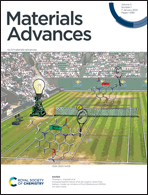Electronic structure of Li+@C60 adsorbed on methyl-ammonium lead iodide perovskite CH3NH3PbI3 surfaces†
Abstract
It was recently shown by Jeon et al. [Angew. Chem., 2018, 57, 4607] that air stability for more than 1000 hours under light illumination can be achieved in methyl-ammonium (MA) lead iodide perovskite solar cells when Li+ is replaced by Li+@C60 in a dopant material used in the p-type donor layer. In order to demonstrate the role of Li+@C60 in the hole transporting material, we carried out first-principles electronic structure calculations of Li+@C60 adsorbed on MAPbI3 using the van der Waals corrected density functional theory. We used finite slab models of tetragonal MAPbI3 (001) surfaces with MAI terminations. Using the most stable MAPbI3 surfaces, we introduced one Li+@C60 molecule on various positions of the MAI surface and performed geometrical optimizations. Then, we found that the Li+@C60 was adsorbed at the aboveC position with almost 100% ionization. There is not much difference between the top and bottom positions of Li+ inside C60, but the bottom position is slightly more stable than the top position. In the MAPbI3/Li+@C60 system, the Kohn–Sham (KS) wave functions of the HOMO and HOMO-1 levels are spread out in MAPbI3 and those of the LUMO, LUMO+1, LUMO+2 levels are localized in Li+@C60; the energy gap between these levels is 0.6 eV. Thus, in the neutral, spin-polarized MAPbI3/Li@C60 system, the KS wave functions of the HOMO (SOMO, – spin) and LUMO (+spin) levels are both localized in Li@C60 and their energy gap of 0.125 eV is very small. This HOMO (SOMO) level behaves as a hole level when it loses an electron to become Li+@C60. Since there are three almost degenerate LUMO+1 and LUMO+2 levels, it is expected to behave as a good hole conductor. As such, we conclude that the use of Li+@C60 molecules in place of the bare Li-ions as dopant materials in the MAPbI3 solar cells can prevent degradation. In any case, regardless of the adsorption geometry, our results clearly show the existence of the energetically isolated hole level localized in the Li@C60, which may successfully contribute to the suppression of the oxidation of the MAPbI3 surface.



 Please wait while we load your content...
Please wait while we load your content...